Editor of Science
Senior scientist journalist
Hidden under the slopes of lush forest in Alberti, Canada, is a mass grave on a monumental scale.
Thousands of dinosaurs are buried here, killed at the moment of full devastation.
Now the PalaeonLoga group came to Creek Pipestone – appropriately nickname “River Death” – to help solve 72 million years of Enigma: How did they die?
Trying to get out exactly what happened here, starts with a huge blow of the departures.
Brute force is needed to shoot a thick layer of the rock covering what the professor Emily Bamporth, which leads digging, describes as “Palaeo Gold”.
While her team starts a more delicate job of removing the layers of dirt and dust, passing from fossilized bones slowly begins to appear.
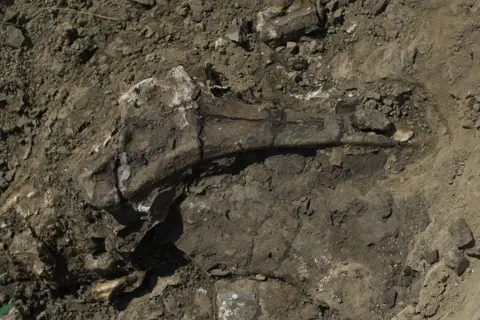 Kevin Church / BBC News
Kevin Church / BBC News“That big spot of the costume, we think, part of the hip,” says Prof. Bamforth, looking at her dog Aster – whose job he barked today if in the nearby bears nearby.
“Then here we have all these long, skinny bones. These are all the ribs. And this is neatly – it’s a part of the legs. We have no idea what it is – it’s a great example of the pipeline’s mystery.”
The BBC News came to Creek Pipestone to testify to the clean scale of this prehistoric cemetery and see how researchers collect marks.
Thousands of fossils were collected from the site and constantly creating New discoveries.
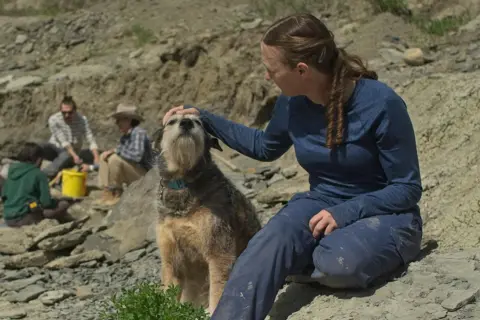 Kevin Church / BBC News
Kevin Church / BBC NewsThe bones everyone belong to the dinosaur called Pachirhinosaurus. Type and Prof. BAMPORTHO’s excavation, characteristic in the new Landmark BBC series – walking with dinosaur – which uses visual effects and science to revive this prehistoric world.
These animals, who lived during the late Credder, were a triceratop cousin. Measurement about five meters and weight two tons, the Four-legged beasts had big headsdecorated with a distinctive rope and three horns. Their characteristic of the definition was a big impact on the nose called the boss.
The dug season has just started and lasts every year until autumn. Fossils in small stains of the country where the team works incredibly incredibly strongly packaged; Prof. Prof. Estimation estimates, at each square meter are up to 300 bones.
So far, her team has dug an area of tennis court size, but the bed of the bone stretches at a mile in the hillside.
“The jaw is in terms of his density,” she tells us to tell us.
“That is, we believe, one of the biggest bone beds in North America.
“More than half of the famous species of dinosaurs in the world are described by one sample. We have thousands of Pahijhinosaurs here.”
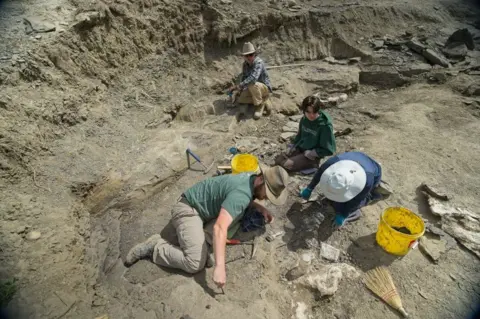 Kevin Church / BBC News
Kevin Church / BBC NewsPaleontologists believe that dinosaurs crossed together in the colossal herd for hundreds of miles from the south – where they spent the winter – in the north for summer.
The area that had a much warmer climate than today would be covered with rich vegetation, providing heavy food for this huge group of animals eaten by plants.
“It’s one community of one type of animal shooting on time and it’s a big sample size. It almost never happens in fossil record,” says prof. Bamforth.
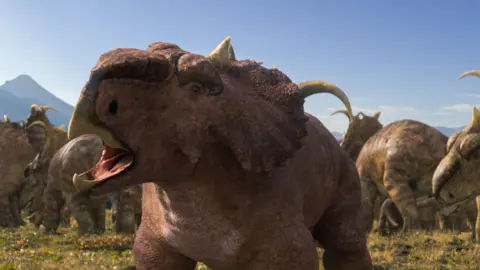 Walking with dinosaurs / BBC Studios
Walking with dinosaurs / BBC StudiosGreater beasts offer clues
And this spot of the Northwest Albert was not only at Pahirhinosaurus. Even larger dinosaurs wandered this country, and studying them necessary to try and understand this ancient ecosystem.
Two hours drive, we get to the cord for a still-border. Coming there entitled through a thick forest, wading or doggie-rowing in case of aster – via a fast river, and a flexible rocky rock.
No digger required here; The super sized bones lie next to the shore, stretched out of the rock and cleaned with running water, just waiting to pick up.
A huge vertebrae was quickly spotted, as well as bits of ribs and teeth, scatter across mud.
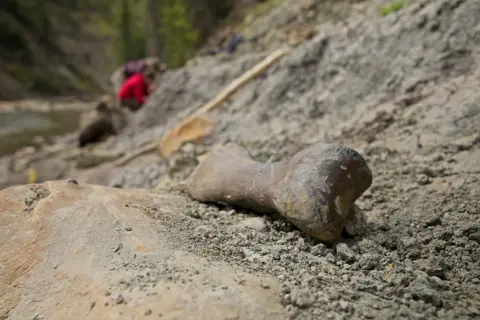 Kevin Church / BBC News
Kevin Church / BBC NewsPaleontologist Jackson Undere is especially interested in what it looks like a piece of skull dinosaur. “Most of what we find is a dipper for ducks called Edmontosaurus. If this is a skull, this is a dinosaur that is big – probably 30ft (10m),” he says.
Edmontosaurus, another birbivor, wandered forests like Pahijhinosaurus – and helps paleontologists build a picture of this ancient country.
Swedjnjak is a collection manager at the Dinosaur Museum of Filip J Currie Dinosaur in a nearby Grande prairie, where they take care of both these greats to clean and analyze. He is currently working on a huge lobby of the Pahijhinosaurus which is about 1.5 m long and was transged “Big alone”.
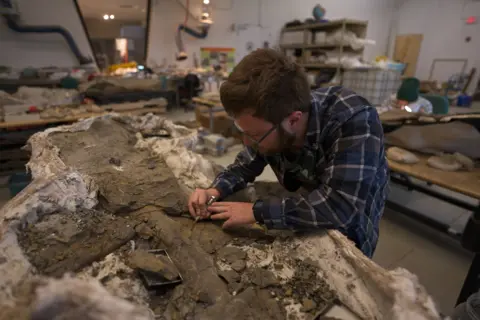 Kevin Church / BBC News
Kevin Church / BBC NewsHe points out where three horns should be on top of Fliil, but the one in the middle is missing. “All skulls that are politely ended in that place in that place,” he says. “But her beautiful little unicorn spike doesn’t look like there.”
Over the years, they work in an extraordinary place, the museum team collected 8,000 dinosaur bones, and the laboratory areas are covered with fossils; There are bones from the pachiahinosaurus of each size, from young to old.
Material of so many animals allows researchers to learn about the biology of dinosaurs, answering questions about how a species grow and make up the community. They can also look at individual variations, to see that one pahirinosaurus could point out from herd – as is the case with a great and its missing spike.
A sudden devastating event
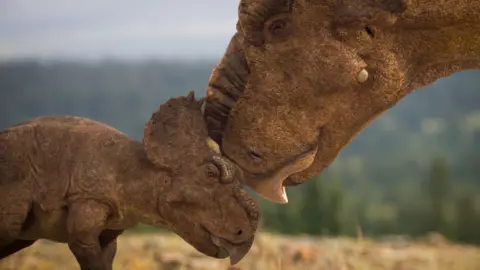 Walking with dinosaurs / BBC Studios
Walking with dinosaurs / BBC StudiosAll this detailed research, in the museum and two locations help the team answers the vital question: How was that animal in Creek Pipestone at the same time?
“We believe that it is a herd at a seasonal migration that tangled in a catastrophic event, which effectively wiped, if not a whole herd, then a good part of it,” says the passage.
All evidence suggests that this catastrophic event was a flash flood – perhaps a storm over the mountains sent by an unstoppable torrent of water towards the flock, ripping trees from their roots and switching the boulder.
Prof Bamforth says Pahirhinosaurus would not stand a chance. “These animals are unable to move very fast because of their magical numbers, and they are very solid – and are really not very good in swimming at all.”
The rocks located on the site show sediment gardens from the rapid flow of water as they all join. It is as if destruction is frozen over time as a wave in stone.
 Kevin Church / BBC News
Kevin Church / BBC NewsBut this day more nightmares for dinosaurs is now a dream for Palaeontologists.
“We know, every time we come here, it’s 100% guaranteed to find bones. And every year we discover something new about the type,” says Prof. Bamporth says.
“That’s why we keep coming back, because we still find new things.”
As the team packs its tools ready to return another day, they know there is a lot of work. They just scratched the surface of what was here – and there are many more prehistoric secrets just waiting to be discovered.
The new series of walking with dinosaurs starts on Sunday 25. May at 18:25 BST on the BBC, with all episodes available on the BBC IPlayer.
 Walking with dinosaurs / BBC Studios
Walking with dinosaurs / BBC Studios





